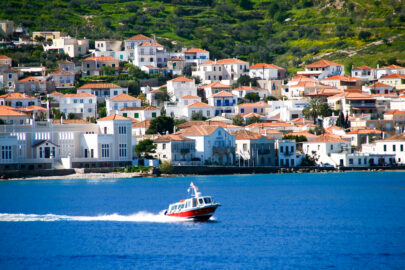The most southerly of the Argo Saronic Islands, Spetses is only minutes away from the mainland but very much part of Aegean Island life. Aromatic and charismatic, Spetses was known as the Isola di Spezie, the Island of Spices, in Venetian times on account of its pine-scented air. Verdant and green, the island was even known in antiquity for its hospitable soil and tree-covered slopes. While most of the pines were planted by a Spetsiot philanthropist dedicated to restoring the beauty stripped by shipbuilders in the 18th and 19th centuries, Spetses is still a welcome emerald oasis at the mouth of the Argolic Gulf. Rarely buffeted by cruel winds, the locals compete to show off the prettiest terraces and gardens and bougainvillea, hibiscus and jasmine spangle the walls of the town in a splash of pinks and mauves.
Strolling through town, mercifully pedestrianised with horse-drawn carriage, bicycle, or on foot as your means of transport, handsome mansions, and neo-classical villas dominate the shoreline between the pi-shaped Old Harbour, Palio Limani, and Dapia where water taxis and fishing caiques are guarded by cannon from the war of independence. Overlooking the jetty where the hydrofoils empty a sophisticated and prosperous crowd, the Poseidonion Grand Hotel stands as an elegant landmark above the statue of island heroine Bouboulina, lending an air of Riviera refinement amid a sea of terracotta rooves.
The history of Spetses is long and storied. Known on Mycenaean maps as Pitiousa, pine-filled, the island was an important commercial trading centre and the pine trees helped to foster a ship-building tradition that continues today. Under Ottoman rule, the central settlement of the island was Kastelli, a castle, a fortified settlement to protect against piracy. Little remains of the defensive walls, were destroyed by the Turks as a punishment for participation in a revolt, and today it is a pretty village of clay-tiled rooves and pebble-mosaiced alleyways.
Ask me anything
Explore related questions





